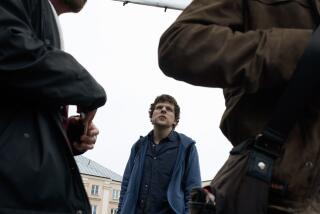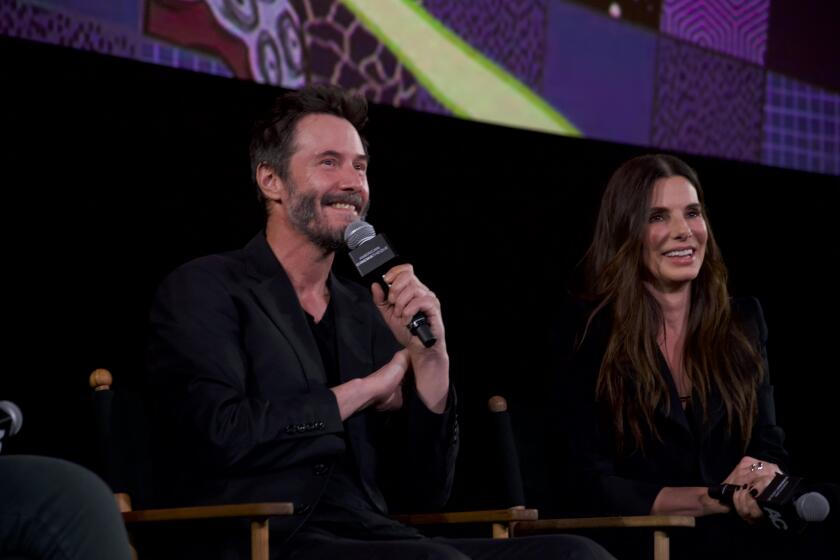Cannes 2015: ‘Son of Saul’ turns a festival upside down
Reporting from CANNES, France — Movies about the Holocaust constitute a longstanding genre, with a wide range of filmmakers plumbing many angles and storylines in the 70 years since the atrocities came to an end.
So a first-time director would hardly seem like the odds-on choice to turn the form on its head.
Yet at this year’s Cannes Film Festival that’s precisely what’s unfolded, thanks to “Son of Saul,” a movie from a Hungarian rookie named Laszlo Nemes that has become the consensus festival breakout.
INDIE FOCUS: Sign up for our weekly movies newsletter
Telling a story of the Sonderkommando -- the Jewish prisoners forced to assist the Nazis in the running of concentration camps -- with a level of verite urgency, the 38-year-old director shows how in the right hands even a well-worn genre can be made fresh. Nemes manages to create a quasi-documentary experience of an event that occurred deep in the past and introduce a new cinematic language to stories of catastrophe.
In the process, he has evoked a kind of stunned hypnosis inside the festival’s theaters and a tangible feeling of excitement outside them.
“It’s a very strange thing. It’s like you’re walking down Broadway,” the director said as he described his Cannes experience in an interview Tuesday, “and in one second everybody just turns and stares at you.”
They can be forgiven their gawking. For the entirety of its 107 minutes,” Son of Saul” (“Saul Fia” in Hungarian) follows the lead character (Géza Röhrig), as he goes about his brutal rounds of cleaning up gas chambers and performing other gruesome tasks at Auschwitz circa 1944 while under the watchful eye of Nazi guards. The movie tethers us to Saul for the entire film, so we are seeing only what he sees and walking only where he walks, lending an uncommon intimacy to a film about death and tragedy.
Shortly after the movie begins, Saul sets upon a single-minded quest (it’s not a big surprise, but it’s more effective to watch the film and discover it for oneself) that he appears to think will retain his own humanity, if not save any lives. (That latter ambition is a pipe dream, though it soon becomes clear that a small resistance is brewing.)
Of course, given all Saul has gone through, his quest may be noble, or simply evidence of a man coming undone.
Many of the horrors in “Son of Saul” -- whose dialogue slides quickly between Hungarian, German and Yiddish -- happen on the edges of the frame or in the out-of-focus background. But the stolen images that our eye catches, of corpses and fires and desperation and chaos, make a deep impression. So do the whispers, cries, gunshots and screams, part of the movie’s devastatingly effective sound design. In the manner of the most potent horror movie, we see and hear just enough to fill in the grim spaces ourselves.
As he hurries about, Saul, however, doesn’t react. It’s a kind of visual equivalent of Hannah Arendt’s banality-of-evil proposition; if you see atrocities every day, at some point you stop noticing them.
Nemes said he structured his film this way because nearly all narrative movies about the Holocaust have left him feeling like something was missing.
“When I think about the experience of how my family died there,” said Nemes, who lost a number of relatives in the camps, “I always thought about what they would see and what they would feel, and how little I know about that. And all the films frustrated me. They seemed like a very external point of view, like they were imposing a lot of postwar emotions on the situations.”
The Sonderkommando became a natural fit in this regard. Though nearly all were killed in the camps, a number of them were -- in contrast to many other prisoners -- able to leave extensive diaries offering a window into their thoughts. The Sonderkommandos’ relative freedom of movement allowed them to find clever hiding places in the ground for the diaries, where liberating soldiers would later find them. (That freedom of movement, needless to say, also allowed Nemes to move the camera around the camp far more than had he gone with another kind of protagonist.)
The Sonderkommando have been the subject of some debate among Holocaust scholars for their role in the camps, but most believe they were victims too, conscripted to a role they never wanted and then murdered anyway.
At a news conference, Rohrig, the actor, reacted strongly to a questioner who said they were regarded as “half-hangman.” “They were not just equally victimized but more victimized,” Rohrig said. “They lived in the epicenter of hell. ... Some of them tried to make their way into the gas chambers themselves.”
But the debate about them may be welcome, Nemes suggested.
“The safe path for the viewer is for us to know where good and bad lies, where the guilt lies, where the bad guys lie,” he said. “There are little signals that most movies use to reassure viewers unconsciously. I wanted people not to have these signals and just to experience a direct visceral sensation.”
Nemes’ technique fits with a vogue that has touched many corners of the movie industry -- an in-the-moment approach that eschews backstory in favor of immediacy. It is not easy to pull off, either technically or narratively, and Nemes has been honing it in several previous shorts as well as with an extensive rehearsal process on this film.
“The idea is how to draw out visual information, to show a single point of view in a cinema which is sometimes very keen on showing a lot, to narrow it down to the limitations of one human being,” he said.
“Saul” is also shot on film, which meant not only a richer look but fewer takes, giving the movie a more spontaneous feel.
He said he was not really influenced by any other narrative films about the Holocaust, but was informed by “Shoah,” as well as the discomfiting frankness of the 1985 Soviet World War II movie “Come and See.”
Nemes, the son of well-known Hungarian director Andras Jeles, cut his teeth on the sets of noted Hungarian auteur Bela Tarr. He studied at New York University’s film school but left after a year, feeling he wasn’t learning much about filmmaking. Though he grew up in Hungary and now lives there, he spent years in the U.S. and France. His English is fluent, and it wouldn’t be surprising to see him make an English-language movie one day.
For now, he says he’s at work on his next movie, another period piece that will follow a young girl in Europe several years before the start of World War I. Nemes says he feels the current crisis in European Jewry has motivated him to take a look at the circumstances that led to this moment, though in keeping with his unconventional approach, he appears to be making films, he laughs, moving backward through history.
Sony Pictures Classics has bought “Son of Saul” for U.S. distribution, and larger accolades -- in Cannes and beyond -- certainly await for Nemes, Rohrig and cinematographer Matyas Erdely.
But those industry concerns, often predominant at a festival, seem to be taking a back seat to “Saul’s” more immediate motivations and effects. “What I want is to show what happened, not through history but by being there,” Nemes explained. “That was what we tried to do -- to allow viewers to use their imagination so we can reach their soul.”
Twitter: @ZeitchikLAT
More to Read
Only good movies
Get the Indie Focus newsletter, Mark Olsen's weekly guide to the world of cinema.
You may occasionally receive promotional content from the Los Angeles Times.











